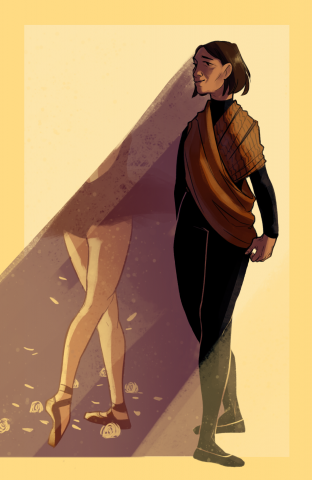“May ballet pala sa Pilipinas?”
(Does ballet exist in the Philippines?)
Such is a question often posed by Filipinos when thinking about the Philippine dance scene. And it is one that Lisa Macuja-Elizalde, Ballet Manila founder and artistic director, hopes to answer—a barrier and a notion that she and many other local ballet enthusiasts strive to dismantle.
Bending the ballet barre
Requiring precision, expertise, and utter perfection from its practitioners, ballet is one of the most demanding forms of dance found within the entire catalogue of the art form.
First performed as an Italian court dance, ballet eventually became the fluttering image of tutus, pointe shoes, and body-hugging spandex, accompanied by gorgeous backdrops and compelling scores. But behind the glamorous displays lie hours of training—of bearing pain and learning to execute the technique-requiring, physically-demanding steps—expected of anyone who chooses to immerse themselves in this form of classical dance.
The discipline that a dancer develops must be at its strictest from the very moment they step into the sacred field. “It took tremendous willpower, drive, ambition, sacrifice, blood—my feet literally bled—sweat, and tears [to dance ballet],” reveals Edna Vida-Froilan, former company director and principal dancer of Ballet Philippines. It’s not just about the stereotypical, feather-like movements, but also the determination one must have to succeed in mastering ballet.

Opening night
Both veterans strive for the integration of ballet in the Philippine dance repertoire. “In Russia, ballet was [already] available on TV [and] in pop concerts…Unlike here, there were balletomanes (ballet fans),” Macuja-Elizalde shares, recounting her experiences traveling to Leningrad (now Saint Petersburg), Russia in 1982 and mastering the Russian Vaganova method of ballet. Simply put, ballet is still a foreign concept in the Philippines, a stark contrast to European nations where it is one of the most respected dance forms.
Vida-Froilan highlights the significant role that Ballet Philippines has played in introducing the art form to the masses; they were the first company to combine classical ballet with contemporary, expressive dancing—dubbing the new style “neo-classic”. Additionally, they were able to reach more people by becoming the first to offer regular ballet seasons, subscription packages, and summer workshops.
“We developed an audience for dance,” Vida-Froilan elaborates, citing how Ballet Philippines would often dance in malls and plazas, and would even tour provinces to help spread the art form throughout the country. “We developed teachers, choreographers, [and] directors, some of who became principal dancers or ran their own dance companies here and abroad.”
On the other hand, Ballet Manila strives to bring ballet to the people and people to the ballet, by finding an angle of the dance form and twisting it—trying to “deconstruct it and explain it,” as Macuja-Elizalde describes. One manifestation of this process was Ballet and Ballads, first staged during the 1997-1998 season of the company. Signifying an attempt to bridge the gap between classical ballet and modern Filipino songs, the show proved to be extremely popular that it was later updated and re-performed for 2018 audiences.
Ultimately, both visionaries keep one goal in mind: to transform ballet into a distinctly Filipino form of dance.
Leaps of faith
As choreographers themselves, it became crystal clear to Macuja-Elizalde and Vida-Froilan that dancing is not an easy job, recognizing several factors hindering the local ballet scene from growing. They both relay the challenges of juggling time spent handling their respective companies, teaching students classical techniques, and performing in front of a crowd of thousands.
“Dance is very popular in the country. The only problem is it is very difficult to produce,” says Vida-Froilan. Considering the budget for equipment, costumes, and schooling that a dancer would need, she urges the government and other private companies to give importance to dance for it is one of the fundamental art forms in the country.
Agreeing with Vida-Froilan, Macuja-Elizalde advocates for the promotion of artists’ rights through Artists’ Welfare Project Inc., an organization fighting for artists to be given discounts and additional benefits that they arguably deserve. “Here [in the country], it’s only the National Artists [who] get [such benefits]. I think it’s time that all artists and cultural workers be acknowledged and given certain benefits for going into this kind of work and this kind of mission,” asserts Macuja-Elizalde.
Swan song
“One never forgets [that] she is a ballerina,” Vida-Froilan affirms even 30 years after her last performances in Desert Passages and as the titular character in Carmen. “How I wish I could still do [warm ups on the] ballet barre…everything is so painful physically when you’re in your 60s,” she expresses, reminiscing in particular her stunning performance as the Firebird in the 1979 production of the eponymous ballet.
While Vida-Froilan fervently encourages future dancers to pursue their craft, she herself has hung up her pointe shoes, venturing into other realms. Nowadays, she focuses on her acting—mainly through one-act plays such as Hintayin ng Langit and Ang Paguulyanin ni Olivia Mendoza—but she still finds time to help Ballet Philippines through choreographing and directing.
“The actual going onstage and performing is what I miss the most [in ballet],” Macuja-Elizalde expresses, citing Kitri from Don Quixote as her favorite role. Given how ballet was such a vital part of her life, Macuja-Elizalde now engages in teaching the young aspirants to hone their skills, offering ballet classes to those interested. As she remarks, “It is my way of giving back.”
Wishing to inspire more individuals to keep the art of ballet alive, Vida-Froilan claims that, “Everyone—young or old, rich or poor, straight or gay, artistic or [from the] corporate [world]—should not only watch ballet, but also take ballet lessons!” The stories shared by these battle-hardened ballerinas are reminders that ballet is a challenging art form, daring dancers and viewers alike to feel the passion and find meaning infused in every pirouette and assemblé.
